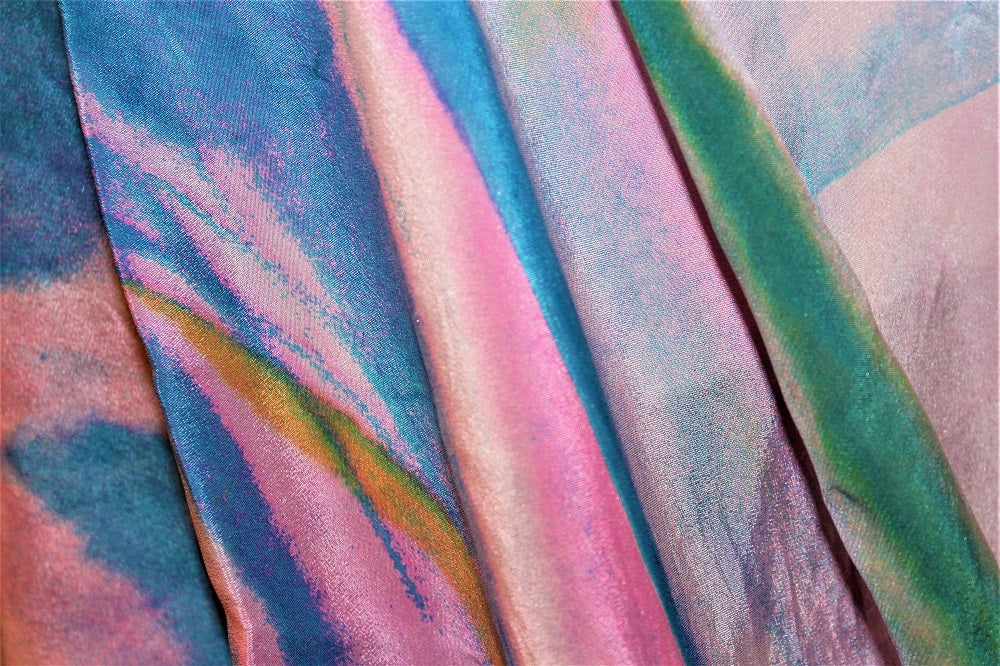We find ourselves in this post around a slightly more technical subject…
That of textile fibers and their impact on the environment.
To help you better understand fashion, what is eco-responsible and what is not.
But also to better understand composition labels when you go shopping!
There are 3 main families of textile fibers:
Natural: the threads are made from plants (cotton, linen, bamboo, etc.)
Artificial: the threads are made from plants transformed by chemistry (viscose)
Synthetic: the threads are made from compounds from petrochemicals
It was by following training on eco-design that my preconceived ideas were shattered.
Did you know that the fiber with the highest CO2 impact is wool???
And yes, sheep release methane in the form of farts, a gas 25 times more warming than C02.
So yes, wool is natural, but it's really not great for the environment.
Ready to get rid of your preconceived ideas?
Let's go !
Natural fibers
We start with natural fibers, those coming directly from nature, which have not been transformed by chemistry but only by mechanics: the transformation of raw material into yarn.
Cotton
Cotton is one of the most used textile fibers. It is natural but its production is highly polluting and resource-consuming.
Cotton crops are subject to massive use of pesticides and fertilizers, most of which are classified as very toxic. You need around 10,000 liters of water per kilo of cotton, or almost 3,000 liters for a t-shirt and 11,000 liters for jeans.
When it comes to transforming the fiber into yarn, the process is also polluting: chlorine is used to bleach the cotton fiber and heavy metals for dyeing.
Choose organic cotton (with certification, GOTS for example) or recycled cotton to reduce your carbon footprint!
CO2 impact: producing 1kg of cotton generates 16.4kg CO2 eq.
Quantity of water used for manufacturing: 10,000 liters of water per kilo of cotton
Water and soil pollution: major pollution by fertilizers, pesticides during cotton cultivation and by chemicals during the manufacturing process (bleaching, dyeing)
Biodegradable: yes

Linen
Flax is a cereal that grows in temperate zones such as the north of France (1st world producer with 150,000 tonnes per year and no less than 80% of production) and Belgium and which does not require any irrigation. Rainwater is enough to grow flax. In addition, very few (or no) pesticides are used in flax cultivation.
For an eco-responsible linen fabric, make sure that the spinning and weaving have been carried out locally. The European Masters of Linen® certification guarantees, for example, that all stages of linen production and processing follow strict standards: the growing, weaving and spinning of linen must be carried out in Europe.
No waste with linen because everything is used: seeds in the food industry, fiber, straw, wood and dust.
CO2 impact: producing 1kg of linen generates 16.7kg CO2 eq.
Quantity of water used for manufacturing: tap water, no irrigation
Water and soil pollution: by possible crop pesticides and by dyeing
Biodegradable: yes

Silk
Mulberry silk is a natural material of animal origin. It is the silkworm that weaves its oval cocoon from a continuous thread that it secretes. It is this thread which is used for the manufacture of silk. Silk is controversial because of its environmental impact and on animal welfare.
Indeed, the vast majority of silk is manufactured in Asia (70% of world production) and to recover the silk, the cocoons are smothered in ovens at 80°C. It is necessary to kill approximately 6,600 silkworms to obtain a single kilogram of silk. Silk cultivation requires the use of fertilizers, pesticides and chemicals, which are harmful to the planet.
CO2 impact: producing 1kg of silk generates 18.6kg CO2 eq.
Quantity of water used for manufacturing: rainwater
Water and soil pollution: by possible crop pesticides and by dyeing
Biodegradable: yes

Hemp
Just like flax, hemp is a cereal that requires very little water and few (or no) pesticides.
CO2 impact: producing 1kg of hemp generates 19.5kg CO2 eq.
Quantity of water used for manufacturing: rainwater, no irrigation
Water and soil pollution: by possible crop pesticides and by dyeing
Biodegradable: yes

Sheep wool
Sheep's wool is the natural fiber for our winter sweaters par excellence. Natural of course, but its manufacturing emits a lot of greenhouse gases: 80.3kg of CO2 eq for 1kg of wool, compared to 10.1kg of CO2 eq for 1kg of viscose.
Greenhouse gas emissions from wool are mainly generated at the fiber production stage (breeding): these high emissions are linked to methane emitted by sheep during rumination and to nitrous oxide generated during decomposition of slurry.
In addition, sheep farming contributes to soil degradation and water pollution.
CO2 impact: producing 1kg of wool generates 80.3kg CO2 eq.
Quantity of water used for manufacturing: 800 liters of water for 1kg of wool
Water and soil pollution: by sheep farms
Biodegradable: yes

Merino wool
Just like conventional wool, merino wool emits a lot of C02.
Added to this is the problem of animal welfare because in the countries where it is raised (Oceania), the merino sheep undergoes the practice of muzzling which consists of removing the raw skin under the animal's tail to avoid the proliferation of myiasis (a larva) which harms the quality of the wool and the yield.
Although New Zealand has banned Mulesing since 2018, Australian breeders ardently defend it and still practice it.
Against muzzling? Choose wool from other countries!
CO2 impact: producing 1kg of merino wool generates 73.8kg CO2 eq.
Quantity of water used for manufacturing: 800 liters of water for 1kg of wool
Water and soil pollution: by sheep farms
Biodegradable : yes

Cashmere
Of all wools, cashmere emits the most greenhouse gases with a record 385.5kg CO2 eq for 1kg of wool (compared to 10.1kg of CO2 eq for 1kg of viscose).
Consume with great moderation!
CO2 impact: producing 1kg of cashmere wool generates 385.5kg CO2 eq.
Quantity of water used for manufacturing: 800 liters of water for 1kg of wool
Water and soil pollution: by sheep farms
Biodegradable: yes
Artificial fibers
Artificial fibers are chemical fibers made from natural organic raw materials (cellulose extracted from plants, animal or plant proteins) or inorganic raw materials.
Originally, artificial fibers were invented to compete with silk and offer cheaper clothing.
 Viscose
Viscose
Viscose is a textile fiber obtained by the transformation of wood pulp into thread using the chemical action of highly polluting solvents.
It is the wood pulp transformation process that poses the most problem for this fiber, which emits very little CO2.
It is necessary to successively use caustic soda, then carbon disulfide and finally sulfates and vitriol (also known as sulfuric acid).
The impact of these chemicals is very real because once released, they pollute the air, water and soil.
Added to this is production that consumes a lot of water and wood, thus contributing to deforestation since 70 million trees are cut down each year to obtain cellulose, the raw material for viscose. In addition, nearly 10,000 liters of water are necessary to manufacture one kilo of viscose.
CO2 impact: producing 1kg of viscose generates 10.1kg CO2 eq.
Quantity of water used for manufacturing: 10,000 liters of water for 1kg of viscose
Water and soil pollution: by solvents used during the process of transforming wood pulp into fiber
Biodegradable: yes

New viscose
There are more eco-responsible alternatives to traditional viscose: these are new viscoses such as Tencel, Lyocell, Modal, Lenpur.
The difference ?
A closed manufacturing circuit: water and chemicals are recovered and then reused, many times.
The forests in which the trees are felled to obtain wood cellulose are sustainably managed and FSC certified.
Synthetic fibers
Synthetic fibers come from non-renewable materials: hydrocarbons.
Polyester
Polyester represents more than 50% of textile fibers produced worldwide with more than 42 million tonnes produced each year.
Concretely, polyester is a petroleum derivative, like plastic.
The oil is treated with different chemical agents (acids, alcohols) and transformed into wire with more or less water, depending on the processes used.
One of the most common complaints about polyester is the fact that it releases microfibers each time it is washed, which end up at the bottom of the oceans.
CO2 impact: producing 1kg of polyester generates 14.2kg CO2 eq.
Quantity of water used for manufacturing: impossible to find this information, if you know the quantity of water needed to produce 1kg of polyester (excluding dyeing), leave us a comment
Water and soil pollution: by the microfibers released during each wash and by the chemicals used during the manufacturing process
Biodegradable: no
 Acrylic
Acrylic
Just like polyester, acrylic is a textile fiber derived from petrochemicals.
Acrylic has a woolly and soft feel, it imitates wool.
It is comfortable and does not crease.
However, it pills very quickly from the first uses of the garment and does not hold up.
It is often mixed with wool to obtain soft…and inexpensive sweaters.
The manufacture of acrylic is polluting and energy-consuming. Just like polyester, it releases microfibers when washing. Finally, the lifespan of acrylic clothing is limited because they are fragile and pill easily.
CO2 impact: producing 1kg of acrylic generates 21.1kg CO2 eq.
Quantity of water used for manufacturing: impossible to find this information, if you know the quantity of water needed to produce 1kg of polyester (excluding dyeing), leave us a comment
Water and soil pollution: by the microfibers released during each wash and by the chemicals used during the manufacturing process
Biodegradable: no
Nylon
Nylon is a polyamide fiber derived from petroleum.
Widely used in the textile industry for its resistance and waterproofing properties, nylon represents 9% of synthetic fibers used in the textile industry.
The nylon manufacturing process is very polluting and energy-intensive.
Its production releases greenhouse gases such as nitrogen oxide or nitrous oxide (N2O) into the atmosphere, which are equivalent to 298 times its weight in CO2.
Just like acrylic and polyester, nylon releases microfibers during various washes.
Widely used for the manufacture of stockings and tights, nylon has a sadly short lifespan estimated at between 3 to 5 days.
However, it takes 14,000m of thread and 750 liters of water to make a single pair, and 30 to 40 years for them to degrade.
Ethical fashion favors the use of Econyl, a recycled nylon, or BioNylon obtained from glucose, a sugar derivative obtained from plants.
For a pair of tights, count 14,000 m of nylon thread and 750 liters of water.
CO2 impact: producing 1kg of nylon generates 20 kg CO2 eq.
Quantity of water used for manufacturing: impossible to find this information, if you know the quantity of water needed to produce 1kg of polyester (excluding dyeing), leave us a comment
Water and soil pollution: by the microfibers released during each wash and by the chemicals used during the manufacturing process
Biodegradable: no
 Elastane
Elastane
Like its cousins polyester, acrylic and nylon, elastane comes from fossil materials and more precisely from synthetic rubber called polyurethane.
Highly appreciated for its elasticity in the sportswear industry, elastane is also known as spandex, k-fiber or Lycra (registered trademark).
Its manufacturing process is polluting and energy-intensive, and washing elastane causes the release of microfibers into the water.
CO2 impact: producing 1kg of elastane generates 20 kg CO2 eq.
Quantity of water used for manufacturing: impossible to find this information, if you know the quantity of water needed to produce 1kg of polyester (excluding dyeing), leave us a comment
Water and soil pollution: by the microfibers released during each wash and by the chemicals used during the manufacturing process
Biodegradable: no
As you can see, there is no quick fix.
All textile fibers pollute in some way: by the greenhouse gases emitted, by the water consumed, by the chemicals used for dyeing.
The solution ?
And manage your budget well.
By favoring recycled fibers and local manufacturing!
Also discover 11 essential labels in the world of fashion as well as the behind the scenes on plastic microfibers released by textiles when they are washed to perfect your knowledge.
Source: data from the Impacts ® ADEME database, with production in Asia







merci beaucoup pour votre commentaire et votre vigilance ! Nous allons corriger cette coquille de ce pas :-) Effectivement 14’000km ça paraît beaucoup haha !
Bonjour, il y a un petit souci de rapport concernant le nylon : l’article parle de 14000km de fil pour fabriquer une paire de collants. Le bon nombre serait plutôt 14000m.
La chose se démontre aisément en revenant à la définition du denier, qui est l’unité d’épaisseur de fil. 1 denier correspond à un fil (imaginaire) pesant 1g pour 9000m. La plupart des bas et collants sur le marché sont en 15 deniers, soit 15g/9000m de fil. Avec 14000km de fil, un collant pèserait… 23kg, ce qui est loin d’être anodin. En réalité, un collant 15 deniers pèserait plutôt environ 23g.
(calcul vérifié avec une paire de bas en pur nylon 15 deniers, taille 6, qui pèse un peu moins de 20g)
Leave a comment